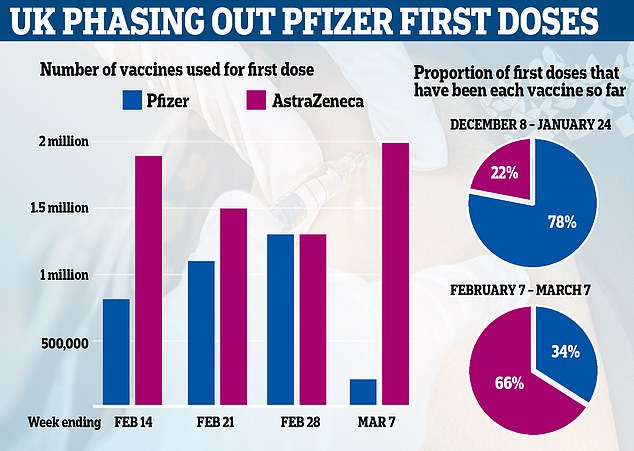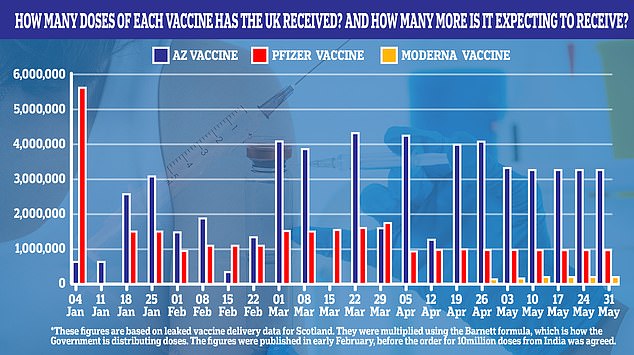Why HAS Britain started to ration Pfizer’s Covid vaccine? Jab was used for just 200,000 new patients out of 2.2million in the first week of March as AstraZeneca’s jab takes over
- EXCLUSIVE: Pfizer jab used for only 9% of first doses in first week of March
- This was a drop from it accounting for three quarters of new patients in January
- UK to get enough doses to immunise 20million people but 50m worth of Oxford
- AstraZeneca’s seems now to be the staple vaccine for first-time patients
Britain has almost stopped giving out the Pfizer Covid vaccine to new patients so it can save supplies for second doses, official data suggests.
The NHS appears to now be rationing the jab, which was used to kick off the rollout in December, and only used it for one in 10 new patients in the first week of March.
In January, when AstraZeneca‘s vaccine first got approved, Pfizer’s still accounted for three quarters of all first doses but this fell to just nine per cent in the first week of March, when only 200,000 new patients were given it.
MailOnline understands deliveries of the Belgian-made jab will be smaller from April because of a planned reduction and there is also a risk the EU will try to rescue its shambolic roll-out and try to block shipments from reaching the UK.
Ministers must be careful with the supply they do get because they’re already over halfway through supplies planned up to June – and they owe around 10m people a second dose.
The Department of Health said everyone will get their second doses within 12 weeks as planned. Both the Department and Pfizer declined to comment on the delivery schedule but insist there is no problem with supplies, amid reports on social media of Britons being told there is a shortage.
AstraZeneca’s vaccine, which is available in much larger quantities, is now taking over as the country’s staple vaccine as medics rattle through the priority lists.
But a hiccup in supplies of that because of a blocked shipment of 5million doses from India – combined with a need to reserve Pfizer stocks – means the number of people getting first doses will be ‘significantly constrained’ in April, the NHS has warned.
This means millions of people in their 40s will likely have to wait until at least May to get their first doses. But Whitehall insiders are still hopeful that some will get jabs ahead of schedule, amid claims under-50s would be invited by Easter.

Statistics from the MHRA show that while 78 per cent of all first doses were Pfizer jabs between December 8 and January 24, this split reversed between February 7 and March 7 so that it only accounted for 34 per cent. Just nine per cent of all first doses in the week to March 7 (200,000) were supplied by Pfizer
Figures in the MHRA’s Yellow Card reports, which record people’s reactions to the vaccines, show that the proportion of first jabs that are Pfizer’s has tumbled.
While 78 per cent of all first doses were Pfizer jabs between December 8 and January 24, this split reversed between February 7 and March 7 so that it only accounted for 34 per cent.
The vaccine was used for 1.2million first doses between December 8 and January 4 before Oxford’s got approval.
AstraZeneca’s came into use on January 4 but by January 24, Pfizer’s still accounted for 78 per cent of all first doses – 5.4m out of a total 6.9m.
Come February, when AstraZeneca’s was being churned out at a rate of 2million per week, the proportion of new patients who were getting Pfizer’s jab started to come down but it remained a mainstay of the rollout.
It had accounted for 60 per cent by February 7, when AstraZeneca started to gain ground.
Weekly data available from early February shows the proportion of weekly first-dose vaccines that were Pfizer ranged between 30 and 50 per cent in February.
But it then plummeted to just nine per cent in the first week of March, when only 200,000 people out of 2.2million were given the Pfizer jab.
In that most recent week the number of second doses was about equal to the number of first doses, suggesting a pivot in the way the jab is being used.
A Department of Health spokesperson said: ‘Vaccines will save thousands of lives and reduce hospitalisations and any vaccine approved by the MHRA is proven to be both safe, and effective.

Supply figures for the vaccines were always expected to dip in April and May, according to projections published by the Scottish Government in January — before the UK had struck a deal for 10million doses from India. Therefore, the India delivery delay is believed to be separate from these figures
‘Health services across the UK are working tirelessly to vaccinate those most at risk and more than 25million people have already received their first jab.
‘We remain on track to offer a first vaccine to over 50s by 15 April and all adults by 31 July.’
The MHRA statistics add to evidence that Britain is phasing out the Pfizer vaccine ahead of an expected drop in deliveries in April.
MailOnline understands ministers are preparing to receive smaller batches of Pfizer’s vaccine from April and leaked files from Scotland’s delivery schedule suggest a reduced supply from the end of March was planned months ago.
This means the Pfizer doses the Government can get its hands on will have to be reserved for the people who have had their first dose and been promised a second one.
Dr Simon Clarke, a microbiologist at Reading University, told MailOnline: ‘We may be getting to the point where they basically stop giving it out as a first dose.’
And James Lawson, of the Adam Smith Institute think-tank, said there appears to be a ‘very worrying gap’ between the number of people vaccinated already and the speed that second dose supplies are coming.
Officials factor second doses into their delivery patterns, with supplies reserved for Britons due a top-up jab. But one-for-one stockpiles are not kept on British soil – they are managed on a ‘rolling basis’.
But the plans for the Oxford/AstraZeneca vaccine have been hit as well this week, with a shipment due to arrive from India being suspended.
Matt Hancock yesterday admitted a delayed shipment from the Serum Institute of India was a key factor in shortages that will slow the campaign down next month, meaning millions of over-40s will have to wait until May to get their first dose.
British ministers have denied that the blame for the delay lays at the feet of the Indian government in New Delhi.
But the boss of the Serum Institute, Adar Poonawalla, yesterday said no further doses would be sent to Britain until the Indian Government gave the go ahead.
He also said there was no shortage and claimed it had never made a deal to supply the full 10million doses within any given time frame.
Whitehall sources said there was a ‘constructive dialogue under way to work through issues’ with counterparts in India.
